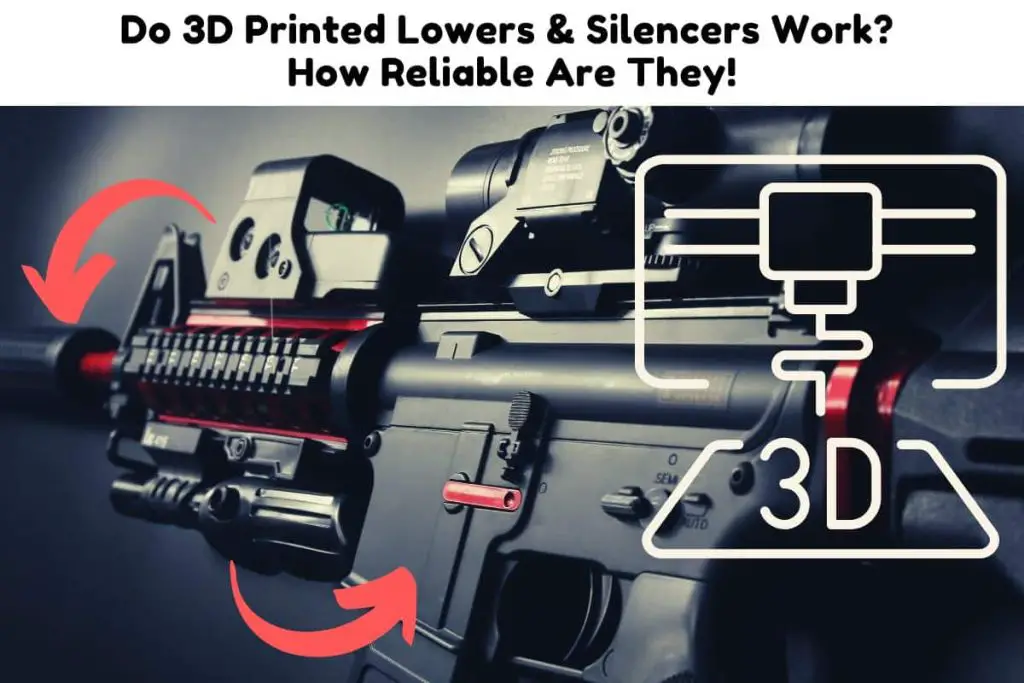In the last decade 3D printing has grown from just prototyping to making practical end user products. Today, you can fabricate almost anything from a 3D printer. But a burning question most have about the technology is how good are 3D printed parts?
A major criticism in the past has been that 3D printed parts can’t stand up to mechanical stress. An example of this is the lower receiver of a rifle.
3D printed lowers do not work. At least not as well as a machined lower. Most 3D printed lowers typically fail after 100 to 200 rounds. The chief reason they fail is anisotropy. This is a phenomenon that affects 3D printed plastics where the printed part fails along the build direction due to weak inter-layer bonding.
The lower, or “lower receiver” is the main component of a firearm. It is where the operating parts which include the trigger group and magazine port of a firearm are. It is what American law defines as a firearm.
On a side note! If you’re looking for a reliable and high-quality 3D printer, we highly recommend the Official Creality Ender 3 V2 Upgraded 3D Printer (Amazon Link).
This printer is an upgraded version of the popular Ender 3 model, with a range of new features and improvements that make it even easier and more convenient to use.

The lower receiver of a rifle experiences substantial mechanical stress from the force and heat generated when the weapon is fired. And this is where the difficulty in 3D printing a lower is. A 3D printed lower cannot withstand the type of force and heat exerted on it. This is why it fails and has not lasted beyond a few hundred rounds in the past.
This is not to say 3D printed lowers are completely non-viable. There are promising reports from makers of 3D printed lowers in development that are lasting for up to 1000 rounds without failing. We also highly recommend that you check out our post “Are 3D Printed Lowers Safe? All You Should Know!“

Can You Resin Print An AR15 Lower?
Resin printing typically produces thinner layers than fused deposition modeling. This can decrease the likelihood of anisotropy or layer peeling under mechanical stress. For this reason, resin printing can produce an AR15 lower with a lesser likelihood of failure compared to fused deposition modeling.
Both resin printing and fused deposition modeling (FDM) have certain pros and cons which make them suited for printing a lower receiver.
Resin printing
Resin printers build parts in layers using resin. Each layer is exposed to UV light to solidify it. There are two types of resin printers, namely DLP (digital light processing) and SLA (Stereolithography).
SLA printers use a laser to trace a path through each layer while DLP printers use a UV LCD screen to cure an entire layer at once. DLP printers are cheaper than SLA. They both offer more or less the same specific advantages and disadvantages.
The biggest disadvantage to resin printers that might not make them ideal for printing a lower receiver is that standard UV resin prints are brittle. They are not particularly suited for parts that will experience the type of mechanical stress a lower is put under.
This can be compensated for by using a specialty or “engineering resin”, however. Engineering resins are stronger and more heat resistant than standard resins. Source
Fused deposition modeling
FDM printers build parts in layers using filament. That’s why it is also known as Fused Filament Fabrication. The filament is deposited by a moving print head on a specified path creating successive layers stacked on top of each other. As the layers stack, the part cools and solidifies.
The advantage of FDM is that it produces parts that are more durable. The improved strength and ability to build bigger parts, make it more suitable for building functional parts like a lower receiver.
While you can build an AR15 lower with resin printing, it might be better to opt for FDM, especially if you consider the material choices you have with FDM. On the other hand, resin printing does give you greater strength in all directions of a print. FDM, as mentioned before, creates 3D parts that are likely to come apart where the layers stack together. Source
Do 3D Printed Silencers Work?
A working silencer can be made with a 3D printer. Depending on the material used, a 3D printed suppressor will have the heat and force tolerance to withstand and most importantly muzzle the report of a firearm.
3D printers have evolved from printing simple Star Wars figurines out of basic plastics. Today, you can make complex prints because of the greater range of print materials available. This includes not just stronger varieties of plastics but metal filaments as well.
The introduction of metal and metal-filled material to 3D printing has vastly expanded the scope of what you can create in your garage. Printer technology has also come a long way as well.
While the materials and technology have come a long way, your standard consumer grade printer might struggle to print the engineering grade materials such as Nylon required to produce high-stress tolerance parts like suppressors and lower receivers.
What Percentage Of 3D Prints Fail?
The failure rate of 3D prints is between 20 to 50 percent. This is more common with beginners. Failure rate among professional printers is lower at between 1 to 10 percent. Aside from experience and expertise, the main factors that increase the chances of print failure are printer settings and material quality.
There are several settings that determine how a print will turn out. The main ones include layer height, print speed, temperature, fill density and shell thickness.
- Layer height determines the height of each layer in your print.
- Temperature is the extrusion temperature used for a specific filament.
- Print speed is the speed at which you print.
- Fill density determines how solid or hollow your print will be.
- Shell thickness sets the thickness of the outer layers of your print.
Very often when a print fails, it is because of using the wrong print settings. If the print settings are optimal, failure might be due to the material itself.
Are 3D Printed Parts Strong?
3D printing can produce parts that are relatively strong depending on their application and the material used. With that being said traditional manufacturing methods like injection molding produce stronger parts. A big factor in how a 3D printed part performs is the material used.
PETG and Nylon are the stronger plastic material types. They have better impact resistance and don’t break as easily under compression as PLA or ABS do. There are also metal alloys where plastic filament is not strong enough to do the trick.
